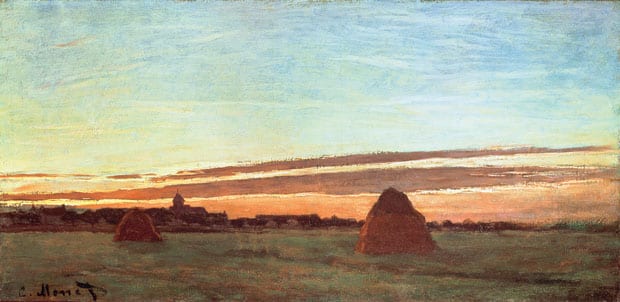Cowtown’s museum exhibition makes a strong Impression(ist)

Monet’s ‘Pointe de la Have below, part of the Kimbell’s permanent collection, inspired this exhibit of his early works, also including ‘Grainstacks at Chailly,’ top, and ‘Luncheon on the Grass,’ below.
 The best news about the Monet exhibit current at Fort Worth’s Kimbell Art Museum is this: This is just Part 1.
The best news about the Monet exhibit current at Fort Worth’s Kimbell Art Museum is this: This is just Part 1.Monet: The Early Years was built around one of the two Monets in the Kimbell’s archives: The Pointe de la Have at Low Tide, painted in 1865, early in the artist’s career, according to George T.M. Shackelford, deputy director of the Kimbell. It inspired Part 1. But Weeping Willow, painted 1918–19, is the other work in the museum’s collection. And in two years time, the museum will mount another exhibit revolving around that painting and focusing on the artist’s later works. But for the time being, we can revel in the artist as a young man.
 The 50-plus canvasses in this show — accumulated from a number of other museums and private collectors — were painted from 1858 to 1872, before Monet became well-known at the first Salon de Refuses, which helped define the Impressionists movement. Depending on how you count, there are 54 or 55 works in this show. The discrepancy revolves around two canvasses called Luncheon on the Grass, which were originally parts of one larger work that was to be submitted to the Salon de Paris. When Monet didn’t finish the painting in time, he rolled it and stored it poorly. In the 1880s, Monet found that parts of the canvas were damaged, so he cut away the ruined portions. What’s left are two magnificent works that fit together quite nicely, but were kept apart for 100 years. Here, they are reunited.
The 50-plus canvasses in this show — accumulated from a number of other museums and private collectors — were painted from 1858 to 1872, before Monet became well-known at the first Salon de Refuses, which helped define the Impressionists movement. Depending on how you count, there are 54 or 55 works in this show. The discrepancy revolves around two canvasses called Luncheon on the Grass, which were originally parts of one larger work that was to be submitted to the Salon de Paris. When Monet didn’t finish the painting in time, he rolled it and stored it poorly. In the 1880s, Monet found that parts of the canvas were damaged, so he cut away the ruined portions. What’s left are two magnificent works that fit together quite nicely, but were kept apart for 100 years. Here, they are reunited.A series of three paintings of Paris are also on display together for the first time in a quarter century. Each is a view painted from the same vantage point from the windows of the Louvre. From a distance, the paintings have create the illusion of substantial detail; upon closer inspection, however, the “people” are mere dots and dashes of paint. Shackelford notes that Monet was genius in using little dots to give his characters movement.
 The show examines how Monet experimented with techniques that eventually became his trademark, but also how he tried various ways in his early years to gain some attention to simply sell some work to support his family. Grainstacks at Chailly at Sunrise was the first time Monet painted haystacks. The water in Seascape is a precursor to many more famous later works filled with comma strokes that coalesce into ponds of lily pads or fields of flowers.
The show examines how Monet experimented with techniques that eventually became his trademark, but also how he tried various ways in his early years to gain some attention to simply sell some work to support his family. Grainstacks at Chailly at Sunrise was the first time Monet painted haystacks. The water in Seascape is a precursor to many more famous later works filled with comma strokes that coalesce into ponds of lily pads or fields of flowers.Several of the paintings are just studies for other works, indicated as just an impression by his initials as his only signature.
Two canvasses from 1869 that were quite experimental and not typical of Monet are still lifes, probably painted to generate sales, Shackelford surmises. A vase of flowers and several paintings done at La Grenouilliere were painted side-by-side with Renoir. (For comparison, Renoir’s versions are reproduced on a label posted next to the Monet.) Two of three snow scenes of the French countryside down river from Paris are from Musee d’Orsay. One, The Magpie, is the Parisian museum’s most popular painting, based on postcard sales. Despite the blankets of snow, the canvases are rich with color.
Monet left France in 1871 during the Franco-Prussian War. Four paintings from his stay in London show a unique insight into his influences. The signature on one — “Claude Monet London” — may have been an attempt by the artist to appeal to a British art collector, according to Shackelford. Meditation, Madame Monet Sitting on a Sofa is painted in the style of James Whistler, whom he knew and admired. The scene and style are quite British.
Before returning to France, Monet traveled to The Netherlands where he painted windmills and canal scenes. While the other Holland scenes reflect the muted, cloudy landscape, Houses by the Zaan at Zaandam jumps off the wall for its vibrancy.
Monet returned to Paris in 1871 where much of the city lay in ruins because of the Prussian siege and then the harsh period of The Commune, a short-lived revolutionary government that ruled for three months after the defeat of Emperor Napoleon III. But Paul Durand-Ruel purchased a number of Monet’s works and the artist and his family moved to Argenteuil where he rented and later purchased his first property and began painting what he became to famous for — the gardens, river and towns outside Paris. At this point, Monet’s fortunes began to change.
For those discovering Monet for the first time, Monet: The Early Years will thrill as they discover how Monet turned delicate and tender brush strokes of vibrant color when viewed up close into a coherent, detailed work when seen from across a room.
But even for art lovers who know Monet’s work well, the show will delight with paintings from private collections that have rarely, if ever, been exhibited and with groups of paintings they may have seen at various museums through their lives but never seen together.
— David Taffet
Kimbell Art Museum
Renzo Piano Pavilion, 3333 Camp Bowie Blvd.,
Fort Worth.
Through Jan 29. $18 (members free).
KimbellArt.org.
This article appeared in the Dallas Voice print edition December 02, 2016.


